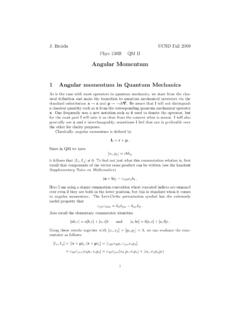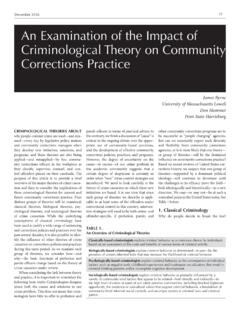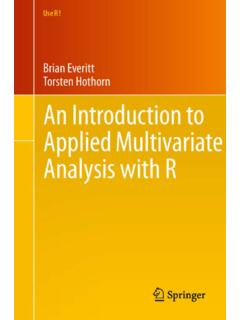Transcription of Introductory Quantum Chemistry Chem 570a: Lecture Notes
1 Introductory Quantum Chemistry Chem 570a: Lecture Notes Prof. Victor S. Batista Room: Sterling Chemistry Laboratories (SCL) 19. Tuesdays and Thursdays 9:00 10:15 am Yale University - Department of Chemistry 1. Contents 1 Syllabus 7. 2 The Fundamental Postulates of Quantum Mechanics 8. 3 Continuous Representations 11. 4 Vector Space 11. Exercise 1 .. 14. Exercise 2 .. 14. 5 Stationary States 15. Exercise 3 .. 15. Exercise 4 .. 15. Exercise 5 .. 16. 6 Particle in the Box 16. Exercise 6 .. 17. 7 Commutator 18. Exercise 7.
2 18. 8 Uncertainty Relations 18. Exercise 8 .. 19. EPR Paradox .. 19. 9 Exercise 9 20. Copenhagen Interpretation: .. 20. Feynman Interview: .. 20. Momentum Operator: .. 20. EPR Paradox: .. 21. Schro dinger's cat paradox: .. 21. 10 Heisenberg Representation 21. 11 Fourier Grid Hamiltonian 24. Computational Problem FGH .. 25. 12 Variational Theorem 25. 13 Digital Grid-Based Representations 27. Computational Problem 1 .. 27. Computational Problem 2 .. 28. 2. Computational Problem 3 .. 29. Computational Problem 4.
3 29. 14 SOFT Method 30. Computational Problem 5 .. 30. Imaginary time propagation .. 31. Ehrenfest Dynamics .. 32. Exercise: Real and Imaginary Time Evolution .. 33. Computational Problem 6 .. 34. Computational Problem 7 .. 35. Computational Problem 8 .. 35. Computational Problem 9 .. 35. 15 Time Independent Perturbation Theory 35. Exercise 9: How accurate is first order time-independent perturbation theory? 36. 16 Time Dependent Perturbation Theory 37. Exercise 10 .. 40. Exercise 11 .. 41. 17 Golden Rule 43. Monochromatic Plane Wave.
4 43. Vibrational Cooling .. 44. Electron Transfer .. 47. 18 Problem Set 49. Exercise 11 .. 49. Exercise 12 .. 49. Exercise 13 .. 50. Exercise 14 .. 51. Time Evolution Operator .. 51. Evolution in the basis of eigenstates: .. 51. Trotter expansion of the time evolution operator: .. 51. Numerical Comparison: .. 51. 19 Adiabatic Approximation 52. 20 Two-Level Systems 53. 21 Harmonic Oscillator 57. Exercise 15 .. 57. Exercise: Analytical versus SOFT Propagation .. 60. 3. 22 Problem Set 61. Exercise 16 .. 61. Exercise 17.
5 62. Exercise 18 .. 62. Exercise 19 .. 62. Exercise 20: Morse Oscillator .. 63. 23 Angular Momentum 65. Exercise 21 .. 66. Exercise 22 .. 68. Exercise 23 .. 70. Exercise 24 .. 70. Exercise 25 .. 71. 24 Spin Angular Momentum 74. Exercise 26 .. 76. Exercise 27 .. 77. Exercise 28 .. 77. Exercise 29 .. 78. 25 Central Potential 79. Exercise 30 .. 81. 26 Two-Particle Rigid-Rotor 82. Exercise 31 .. 82. 27 Problem Set 82. Exercise 32 .. 82. Exercise 33 .. 82. Exercise 34 .. 82. Exercise 35 .. 83. Exercise 36 .. 83. Exercise 37.
6 83. 28 Hydrogen Atom 83. Exercise 38 .. 85. Exercise 39 .. 86. Exercise 40 .. 86. Exercise 41 .. 86. Exercise 42 .. 87. 29 Helium Atom 88. 4. 30 Spin-Atom Wavefunctions 89. 31 Pauli Exclusion Principle 90. 32 Lithium Atom 91. Exercise 44 .. 92. 33 Spin-Orbit Interaction 92. Exercise 45 .. 94. 34 Periodic Table 94. Exercise 46 .. 96. Exercise 47 .. 96. 35 Problem Set 96. Exercise 48 .. 96. Exercise 49 .. 97. Exercise 50 .. 97. Exercise 51 .. 97. 36 LCAO Method: H+ 2 Molecule 97. Exercise 52 .. 98. Exercise 53.
7 100. 37 H2 Molecule 101. Heitler-London(HL) Method: .. 103. Exercise 54 .. 103. 38 Homonuclear Diatomic Molecules 103. Exercise 55 .. 107. 39 Conjugated Systems: Organic Molecules 108. 40 Self-Consistent Field Hartree-Fock Method 110. Restricted Closed Shell Hartree-Fock .. 114. Configuration Interaction .. 118. Supplement: Green's Function .. 118. 41 Second Quantization Mapping 123. Single-Particle Basis .. 123. Occupation Number Basis .. 124. Creation and Anihilation Operators .. 124. Operators in Second Quantization.
8 125. Change of basis in Second Quantization .. 127. 5. Mapping into Cartesian Coordinates .. 127. 42 Density Functional Theory 129. Hohenberg and Kohn Theorems .. 131. Kohn Sham Equations .. 132. Thomas-Fermi Functional .. 133. Local Density Approximation .. 134. 43 Quantum Mechanics/Molecular Mechanics Methods 136. 44 Empirical Parametrization of Diatomic Molecules 137. Exercise 56 .. 140. Exercise 57 .. 141. 45 Discrete Variable Representation 143. Multidimensional DVR .. 146. Computational Problem 15 .. 146.
9 46 Tunneling Current: Landauer Formula 147. WKB Transmission .. 150. 47 Solutions to Computational Assignments 153. Problem 1 .. 153. Problem 2 .. 156. Problem 3 .. 161. Problem 4 .. 164. Problem 5 .. 170. Problem 6 .. 171. Problem 7 .. 182. Problem 8 .. 200. Problem 9 .. 217. 6. 1 Syllabus The goal of this course is to introduce fundamental concepts of Quantum Mechanics with emphasis on Quantum Dynamics and its applications to the description of molecular systems and their inter- actions with electromagnetic radiation.
10 Quantum Mechanics involves a mathematical formulation and a physical interpretation, establishing the correspondence between the mathematical elements of the theory ( , functions and operators) and the elements of reality ( , the observable proper- ties of real systems).1 The presentation of the theory will be mostly based on the so-called Orthodox Interpretation, developed in Copenhagen during the first three decades of the 20th century. How- ever, other interpretations will be discussed, including the 'pilot-wave' theory first suggested by Pierre De Broglie in 1927 and independently rediscovered by David Bohm in the early 1950's.




